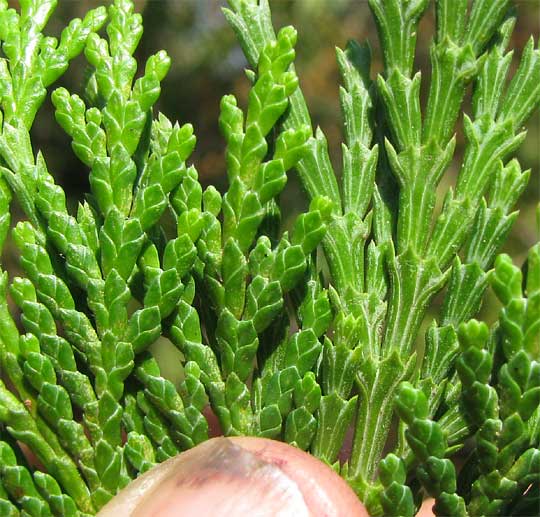Excerpts from Jim Conrad's
Naturalist Newsletter
from the August 23, 2009 Newsletter, issued from the Siskiyou Mountains west of Grants Pass, Oregon:
PORT-ORFORD-CEDARS
The other day when my friend Romain drove me home from the Red Butte backpacking trip he spotted some Port-Orford-Cedars, CHAMAECYPARIS LAWSONIANA, along a stream in the little valley right below my current home base. I thought I'd familiarized myself with all the trees and bushes in that valley but here I'd been overlooking what may be the most interesting species of all. For, Port-Orford-Cedars are narrowly endemic just to southwestern Oregon and far northwestern California. I'd been assuming that they were Incense-Cedars, which are abundant here, but Romain pointed out subtle differences. From a distance, Port-Orford-Cedars are darker, denser and more slender-topped than Incense-Cedars.
None of our trees stands apart enough to provide a good picture of its form, but you can compare the Incense-Cedar's broad, flat branches at http://www.backyardnature.net/n/w/inc-cedr.htm with the Port-Orford-Cedar's slender, drooping ones shown below:

Below, the Port-Orford-Cedar's scaly branches are shown close-up on the left, while the Incense-Cedar's analogous branchlets appear on the right. You can see that the Incense-Cedar's scale bases are much longer than the Port-Orford-Cedar's.

One interesting little fieldmark for Port-Orford-Cedars is what my field guide refers to as "conspicuous silvery X's" on the foliage. You can see what they're talking about below:

"Cedar" is a name given to any number of species in various genera scattered through several families. Port-Orford-"Cedar" and Incense "Cedar," while both belong to the Cedar or Cypress Family, the Cupressaceae, belong to entirely different genera and bear very different fruits. Neither is closely related to the East's Redcedars, which are junipers. Port-Orford-Cedars are more cypress than cedar. Some authorities now place it in the genus Cupressus.
In the wild the species is seriously threatened by a root disease caused by the introduced fungus Phytophthora lateralis. The disease is mainly spread in soil brought in by logging trucks and off-road vehicles, so here's hoping they don't log our little valley below or put ORV trails through it.
The city of Port Orford, by the way, is the oldest and most westerly town on the Oregon coast. I think we must be at the very edge of the species' eastern distribution.